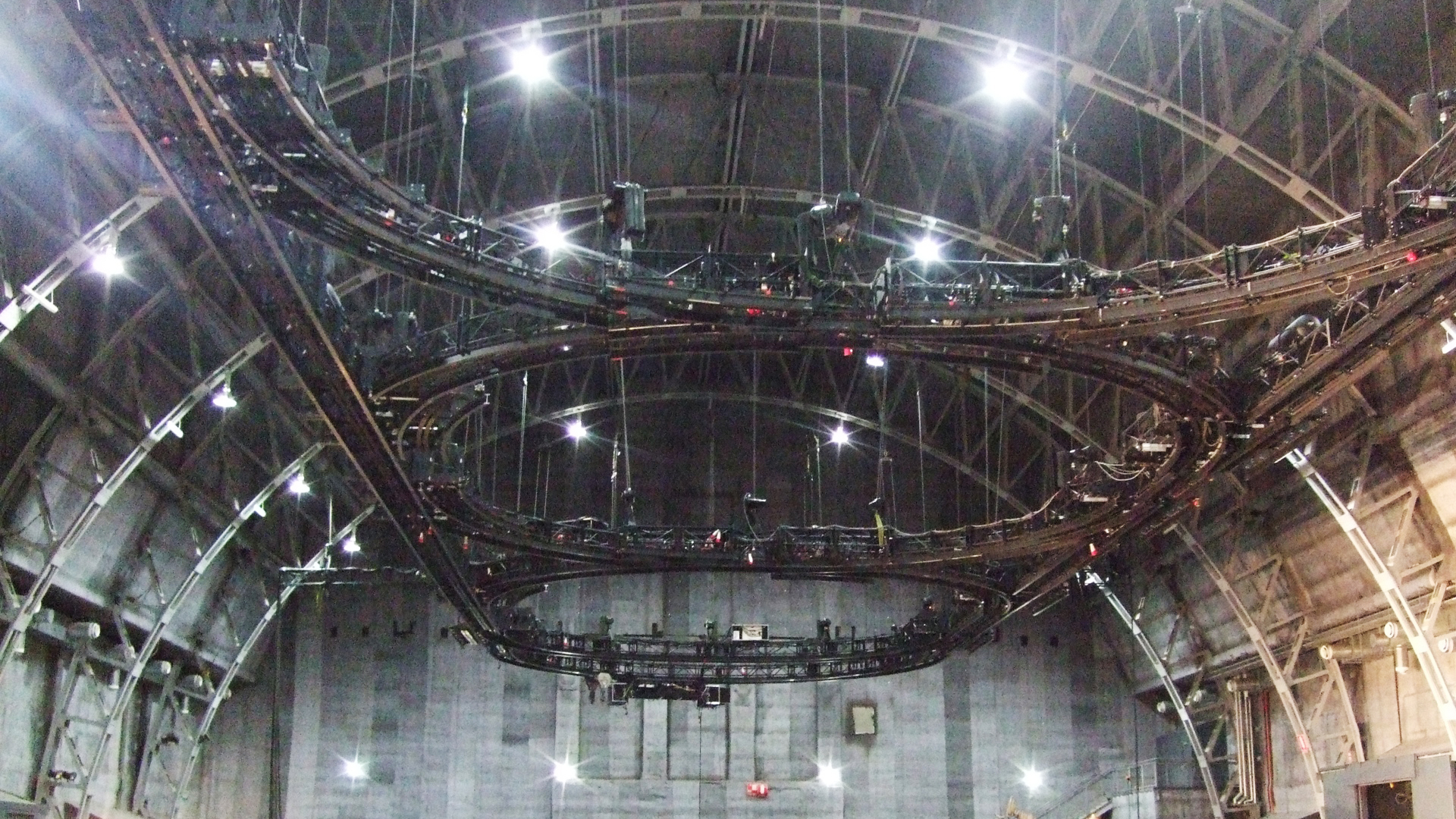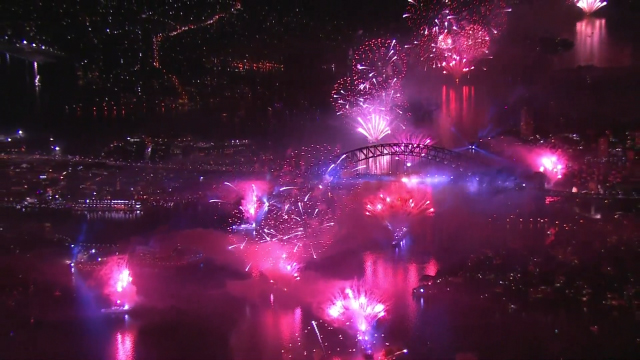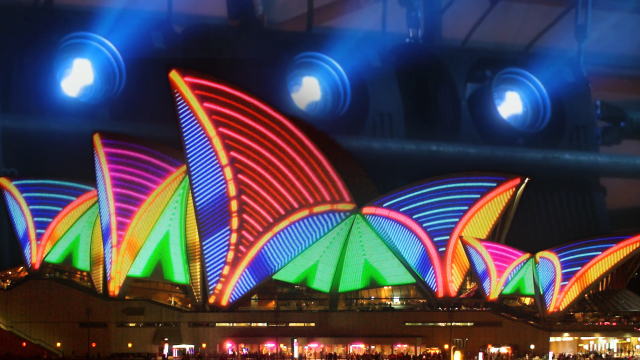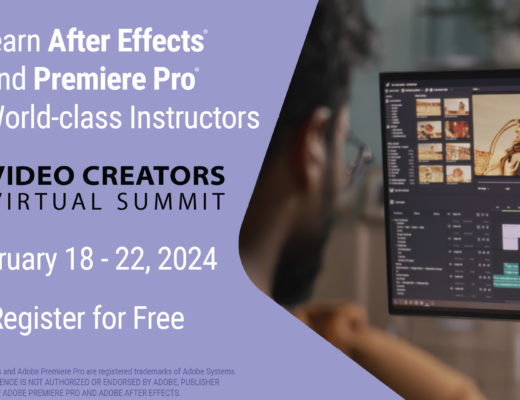In 2009 I had never heard of projection mapping, or building projections, so when a friend of mine emailed me a link to a video on YouTube, the result blew my mind. I had never seen anything like it before, and little did I know that what I had seen represented the birth of a new genre – the building projection – and about a year later I’d be working on something similar.
Recently, I was invited to give a presentation on some of the projects I have worked on over the last few years. Many of these projects include what I call ‘large scale video projection’ – work that’s created or projected at scales well beyond conventional TV.
As I sifted through archives to collect video clips together, I began to see a development in the way large scale projections have been conceived, created and viewed over the past 6 years. As the medium developed, many of the projects I worked on represented a step forward from previous jobs – so as I assembled them in chronological order they also represented increasing stages of maturity.
By including a few projects that I didn’t work on myself, I was able to fill in some gaps and demonstrate how video projection has moved out of an artistic niche and into the mainstream. The projects that I chose to present are collected here, but this article is obviously a personal observation and based on projects that I either worked on myself, or were created by companies I worked for. I’m not suggesting that the specific projects here are all groundbreaking or historically unique (although some are), they’re just the examples that I had access too.
They do, however, definitely demonstrate the progress that large scale video projection has made, not just technically, but conceptually – from artistic installations to a mainstream genre.
Step 1: Artistic niche. Building projections go viral.
Case study: Kimberley Hall
Created & Produced by: Paul Reynolds & Bruce Ferguson
Sp-projects.co.uk
In various forms, the technique of projecting lights and even film footage onto objects has been around for a while. It’s been used in Disney rides, artistic installations and theatre productions. You could even argue that Maurice Binder’s title sequences for the early Bond films are a form of projection mapping – he just used naked women instead of buildings.
But at some point, someone had the idea that if you took a photo of a building and projected it back onto the building, you could create all sorts of great effects and illusions with computer animation.
That person was Paul Reynolds, and in 2009 he teamed up with Bruce Ferguson to create a building projection for a private party being held at Kimberley Hall in the UK. As a specific type of projection mapping (a broader term), the Kimberley Party in 2009 represents the first example of building projection.
Paul writes:
Projection has always been a great love of mine, I used to paint backdrops in the 80s for warehouse events and small parties around the globe, then incorporated projection into the painting to create a different perspective and make people look twice at a piece of art. This was done with UV art on canvas which had holes cut out of it, then rear projected through layers of mesh. Simple slide projection was used back then.
Technology progressed and I was influenced by a number of artists and technicians who worked on a large scale and used big bits of kit to produce light projections – Pod Blumen and Ross Ashton just to name a couple of local lads*A place we partied at for years with the most amazing people was Kimberley Hall, and with the idea of using the knowledge I had gained throughout the years – and still with the goal of changing people’s perception – I proposed that we project onto the house to begin the party. The organisers of the event loved my idea and so we set about creating it.
I teamed up with a great friend Bruce Ferguson, who I had met a few years before when I was running an underground party scene in New Zealand. His After Effects skills were and still are the best I have ever seen, so I knew he was the ingredient needed to make this happen. He was in the UK and happened to be setting up home here, so we collaborated.
We set about the project by first taking a picture from the projector position and then using this as the template to create a bunch of effects that would work on a very happy bunch of party people. The projector used was a Christie Roadster 20k and we just focused content on the central section of the house.
It took about a week on and off to create all the content in After Effects, and a lot of time on the 2 days prior to the show. The day of the set up, the projector was put on the top of a van and driven into position. We had a Mac Pro inside the van running Modul8. The line up was almost perfect when we threw light on the building – a couple of tweaks and we were good to go.Once everyone gathered in front of the house, I knew that the moment I pressed go people would be blown away- we had people running away from the house thinking it was falling! The show was played twice that night and then everyone went into the house to party.
As you can imagine once something like this goes viral the phone didn’t stop ringing and we were inundated with people with buildings to project on.
These days the format is slightly different, but we still specialise in large format projection. We always produce 3D scans of the buildings and work with 3D packages to produce content as well as After Effects.There are a lot of great artists out there and it still fills me with joy to think a lot of the great work that has been produced has in some way been influenced by the work we did on Kimberly Hall.
*Paul also added in a later email that he was influenced by Krzysztof Wodiczko, who has been the subject of a PBS documentary.
Historically, we can look at the 2009 Kimberely Hall party as representing step 1 in the evolution of modern large scale video projection. You can think of it as an origin story.
Kimberley Hall, 2009. The first building projection I ever saw.
What’s significant is that it was conceived by someone with a background in fine arts, approaching the project as an artistic installation. In Paul’s own words, the underlying premise of the project was to change people’s perceptions. It was made in about 1 week by two people, and was only shown twice on the same night.
While the video of the night – and the very concept of building projections – went viral to a global audience, we can look back at the Kimberley Hall project as something that has more in common with an exhibition at an art gallery than a commercial endeavor. The original audience was only a few thousand people, and if it wasn’t for YouTube then the only people who ever saw it would have been the ones at Kimberley Hall that evening.
Paul still works on projection projects around the world, and his website contains lots of impressive videos of more recent projections.
Many thanks to Paul Reynolds for taking the time to share the background behind that groundbreaking project.
Step 2: Global audience. Interaction of multiple elements.
Case Study: 2010 Vancouver Winter Olympics
Created by: David Atkins Enterprises
Produced by: Spinifex
An Olympic opening ceremony is a huge event with a massive global audience, so it’s fair to say that the 2010 Vancouver Winter Olympics took large scale video projection out of an artistic niche and introduced it to the world.
The opening ceremony for the Vancouver Olympics was designed by David Atkins, and the bulk of the animation was done by Matthew Lock and Jamie Tufrey at Spinifex. I was working at Spinifex at the time, but I was not personally involved in this project – I was told that Matt & Jamie deserve all the credit.
When I told the producers at Spinifex I wanted to show a clip from Vancouver they were a little mystified, as it’s 5 years old and they didn’t think it was very exciting anymore. But I wanted to show the progression of large-scale projections over time and the scale of Vancouver represents a step forward from Kimberley Hall. From a technical perspective the Kimberley Hall projection used 1 video projector, while the Vancouver stage used 54.
2010 Winter Olympics opening ceremony. Animation showreel by Spinifex.
But more significantly, the video content itself is now part of a larger theatrical event. There are actors interacting with the video content, and in this particular scene you’ll see a herd of whales swimming along. The whales are computer animations being projected onto the floor, but the jets of water are real – some type of fountain mechanism was built into the stadium ground that is synchronized with the video.
Live broadcast showing interaction with actors, and physical special effects.
So there’s interaction between the animated video content, actors, and physical special effects such as water jets.
As an opening ceremony, however, the show was only ever performed once – even if it was to a global audience in the hundreds of millions.
Step 3: Trickle-down creativity. Corporate communication.
Case study: Alfa Bank
Created by: David Atkins Enterprises
Produced by: Spinifex
In 2010 David Atkins once again teamed up with Spinifex to work on the worlds largest building projection.
While the Kimberley Hall projection used a single video projector, and the Vancouver stage used 54, the massive Alfa Bank project used a staggering 81 video projectors! Many of them were doubled or even tripled up to provide the necessary brightness for such a huge building. For more detailed information on this massive undertaking, check out my earlier video on building projections.
So while the Kimberley Hall project was essentially an artistic installation, and the Vancouver Opening Ceremony introduced large-scale projections to the world, the underlying creative concept has now trickled down to enter the world of corporate communication.
The Alfa Bank project was a commercial marketing event on a massive scale. As well as being technically demanding, it was also very extravagant. Many animators worked for months to produce about 30 minutes of content, all in some way linked to the central theme – the anniversary of the Alfa Bank.
This is only a short exceprt of about 30 minutes of animation.
Like the Vancouver project, the Alfa Bank videos included interaction with live performers, although there were fewer of them. The show began with an actor swinging an oversized hammer down onto a carnival-style strong-man game, and the show also included a professional climber scaling the building, but as with our previous examples, the event was only staged once.
Step 4: Projections enter the mainstream. Annual festival.
Case study: Vivid festival. 2013 Opera House projections.
Produced by: Spinifex
You may not have heard of the Vivid festival, but it’s the largest video and lighting festival in the world. For three weeks every year the centre of Sydney becomes a canvas for all sorts of lighting and video installations. While the first festival in 2009 was based around static lighting & projections, the festival quickly evolved to feature animated building projections.
The Vivid festival. It’s kind of a big deal. This was made in 2012 – you should see it now!
These days Vivid is synonymous with building projections – and I couldn’t tell you how many buildings are involved as the number grows every year. However without doubt the most prestigious feature of Vivid is the projection onto the Sydney Opera House – and in 2012 the festival used video projection on the Opera House for the first time.
For many different Vivid Festivals over the past few years, Spinifex have been involved with projections on many different buildings – they still are – but in 2013 they were awarded the landmark Opera House installation. You can read all about the Opera House projection here – while a large team at Spinifex collaborated on the overall project, I was responsible for the neon light section.
Excerpts of the Opera House projections by Spinifex in 2013.
While the previous projects that I have mentioned were only screened once or twice, the Vivid festival runs for 3 weeks with many projections running on a continuous loop for that time (in the evening, when it’s dark of course).
Since the first extensive use of video projection in 2012, the Vivid festival has continued to grow – and for 3 weeks every year all sorts of video projections and other lighting installations are front and centre on a huge national stage.
Step 5: What goes up also comes down. Smaller scale projections.
Case study: Volkswagon Golf launch.
Produced by: Spinifex
While the Vivid festival takes over Sydney for 3 weeks a year, and the Russian Alfa-Bank projection was the most extravagant ever staged, not all projections have to be on such a large scale.
As the scale of building projections increased over the years, they also decreased as companies around the world explored the creative possibilities for small internal spaces – as well as small budgets.
This launch video for Volkswagon – again by Spinifex – is an example of a much smaller corporate event than the Alfa Bank project.
Launch of the 2015 Volkswagon Golf.
While the Alfa Bank project used 81 cutting edge video projectors, smaller indoor events like the launch of a car may only require one, and even then it doesn’t have to be the biggest or brightest projector on the market. Staging the event inside a theatre, conference centre or other indoor venue also keeps the cost well down when compared to larger outdoor locations.
This is an example from a press event to launch the new Golf at one of the major car shows held around the world. Compared to the massive Alfa Bank project, it’s a technically modest setup (and much cheaper!) and yet the end result is still very striking.
Step 6: Adoption by the theatrical world
Video projections were making an impact on theatrical productions, and in 2011 David Atkin’s Melbourne production of the Broadway hit “Hairspray” used computer animation to entirely replace traditional theatre sets.
This new production did away with the scenery and design which had been part of the show on Broadway, London and all other ports the show has since played, replacing them with screens where the latest in video imagery were projected to glorious, theatrical effect. The show went from a standard Broadway show to a sort of wonder-world of colour and movement, where the entire audience was transported into the super-coloured Tom and Jerry-esque cartoon world that surrounded the actors. The technicalities needed for this was extraordinary and totally original, I’ve never seen projection of this nature on stage in a full scale musical anywhere in the word.
While Hairspray was groundbreaking in its use of animation, two years later came the most ambitious theatrical event ever staged in Australia – the stage adaption of the film ‘How to train your dragon.’ This wasn’t just a stage show, this was an arena spectacular!
Case Study: How to train your dragon
Produced by: Spinifex
Not only was the stage a completely digital projection, but a huge collection of robotic dragons (created by Global Creatures) were featured alongside the main cast members.
How to train your dragon – the Arena Spectacular!
In this case, actors were interacting with the projected video for the full duration of the show. Even the opening title featured a gag that relied on the actor performing in sync with the digital projection, which was also enhanced by pyrotechnics.
Spoiler alert – he doesn’t really rip the screen.
But perhaps the most impressive part of the show was an opening sequence which was simply called the “cliff run”. This 2 ½ minute sequence was single-handedly created by Jamie Tufrey at Spinifex, using Cinema 4D and After Effects.
The cliff run was created by Jamie Tufrey at Spinifex, using Cinema 4D and After Effects.
You can see that this carefully choreographed sequenced included the actor being suspended from a wire rig halfway up the screen. The use of computer animation and projection gave theatre viewers the impression they were looking down on the action from above – something you can’t normally do in a theatre show. But in reality the actor is scaling the wall vertically and the video creates the illusion.
More gorgeous Dragon scenery courtesy of Matt Lock at Spinifex.
The other breathtaking scenes involved the dragons flying, which involved the use of a high-tech track system in the roof which allowed the dragons to fly around, a bit like an upside-down train set.

The most expensive train set you’ll ever see. Dragons not included.
The interesting thing to note about the flying scenes is that the flight path and camera movement was planned out in a 3D application first (using 3D Studio Max). Once the background animations were rendered, the same camera data was exported to the robots and used to control their overall position – including roll, pitch and yaw. So as the animation played out on the huge digital stage, the dragons moved in perfect sync.
Case study: Clusters of Light
Produced by: Spinifex
You might think it’s difficult to top robotic dragons, but the following year Spinifex undertook production of the most elaborate stage show you’ve never heard of. Although the production was officially called “Clusters of light”, we generally referred to it as ‘The Sharjah project’.
Sharjah is a city a short distance from Dubai in the Middle East. Over the past few years it’s been expanding rapidly with a huge number of infrastructure projects. One of these was the construction of a brand new amphitheater, and to celebrate the completion and opening of the theatre,“Clusters of light” was commissioned – starring the absolute elite of middle-eastern musical talent.
Not only were the backdrop and the stage floor digital projections, but a moving prop called the cabah was also projected onto, even as it moved and rotated around the stage.
The graphics in the Sharjah production ranged from relatively simple motion graphics, used as supporting backdrops for solo performances, to Hollywood level visual effects that again relied on the interaction between the actors and the projections.
Something else novel in this production was the use of drones, or quadcopters. There is a company in Austria that has figured out how to fly large numbers of drones in formation, and to choreograph them much like a troupe of dancers. They call them “Spaxels”, which sounds a bit rude, but isn’t really.
The flashing lights in the sky are actually a flying squadron of drones.
In this sequence you can see the drones flying in formation and lighting up in sync with the video – those flashing lights in the sky are not just regular theatre lights, they’re a squadron of individual quadcopters!
Step 7: Narrative structure. Largest event in Australia’s History.
Case study: International fleet review, Royal Australian Navy
Produced by: Imagination (Sydney)
2014 marked the Royal Australian Navy’s 100th birthday, commemorated by a huge event in Sydney Harbour called the “International Fleet Review”.
Produced by the Sydney office of Imagination, this event was the most complex of its kind ever staged in Australia, and remains the highest rating broadcast ever on the ABC. Prince Harry turned up to have a look and check out the show, so we didn’t want to disappoint him.
In terms of large scale video projections, this one had a number of firsts. It was the first time anyone had projected video onto both sides of the Opera House, and it was the first time anyone had simultaneously projected onto both Pylons of the Harbour Bridge. With the Maritime Museum in Darling Harbour also being projected onto, this meant that that video content for the show was being projected onto 5 different surfaces at the same time.
Beyond these technical firsts, however, was also the fact that the video being projected followed a very clear structure, and in places it was almost documentary in style. This wasn’t simply a collection of visual gags, this was a carefully scripted production with a clear premise and a narrative (thanks to creative director Anna Meister). Although it was being projected onto buildings, this was a video that told the story of Australia’s Navy.
This short section on World War 2 tells a story.
I wanted to mention something of a personal anecdote or observation. The video content was clearly divided into 7 different scenes with different themes, and one of those was about the future. The original storyboards for this section used the familiar matrix-style green “digital rain” effect to symbolize the future. Now as much as I love the matrix (the original film is still awesome) it has always bugged me how this effect has been re-used and re-used to represent the future.
In my mind, green glowing text on a black background does not represent the future, it represents the 1970s. So when I began animating this scene, one thing I did was tweak the colour scheme so it wasn’t quite so green, and also to introduce a few secondary colours so it wasn’t monochrome. I was pretty happy with what I had done and I thought the result was much more modern and futuristic.
However once the creative director saw my version I was told that the green theme had actually come from the fireworks designers, and everything had been designed to be green so it all matched up – so this was a reminder that our video projections were only one part of a much larger show that included not just fireworks, but also major lighting installations – not to mention every ship in Australia’s naval fleet.

Step 8: Permanence. There’s no end in sight.
Case study: Ninjago, Legoland
Produced by: Artists in Motion
Every project I have mentioned so far has been temporary – the Kimberley Hall projections were played twice on a single night, the 2010 Olympics only opened once, the Vivid festival runs for three weeks, and even theatrical shows have limited shows.
But the job I have just finished working on is a permanent installation at Legoland.
Similar to How to train your dragon, it’s a theatrical show with projected sets – a wall and the floor – but this time with puppets instead of robotic dragons. However unlike every other project I’ve mentioned so far, this one is a permanent installation.
The soundtrack is completely pre-recorded, including all of the character’s voices, so the show doesn’t rely on specific talent to play each role. There’s a large team of puppeteers who rotate performances, so if an individual gets sick (or leaves the show altogether) then another is always on standby to take their place. The good thing about puppets is that they don’t get sick themselves, and because they’re performing to an existing soundtrack they don’t need to worry about remembering their lines.
Early rehearsals… at the top is a live-action recording, underneath is the raw video.
There is no end-date for the show – it could potentially run for many years.
Conclusion
In the six years since the first Kimberley Hall building projection, large scale video has moved out of the artistic niche it initially occupied and well into the mainstream. There are lighting and video festivals all around the world that feature projection mapping in some form or another, and the theatrical world continues to integrate video projections into stage shows.
As I said at the beginning – I’m not suggesting that every project here is historically significant – I’ve just used these examples because I had them. But they do represent a clear progression in the creative applications, the commercial adoption, and the public’s awareness of large format video projections.
Many thanks to the companies featured here, and to AGDA for inviting me to present at their New Frontiers evening.
This article has featured the work of the following companies:
Sp-Projects (Paul Reynolds)
David Atkins Enterprises
Spinifex
Imagination (Sydney)
Artists in Motion

Filmtools
Filmmakers go-to destination for pre-production, production & post production equipment!
Shop Now













